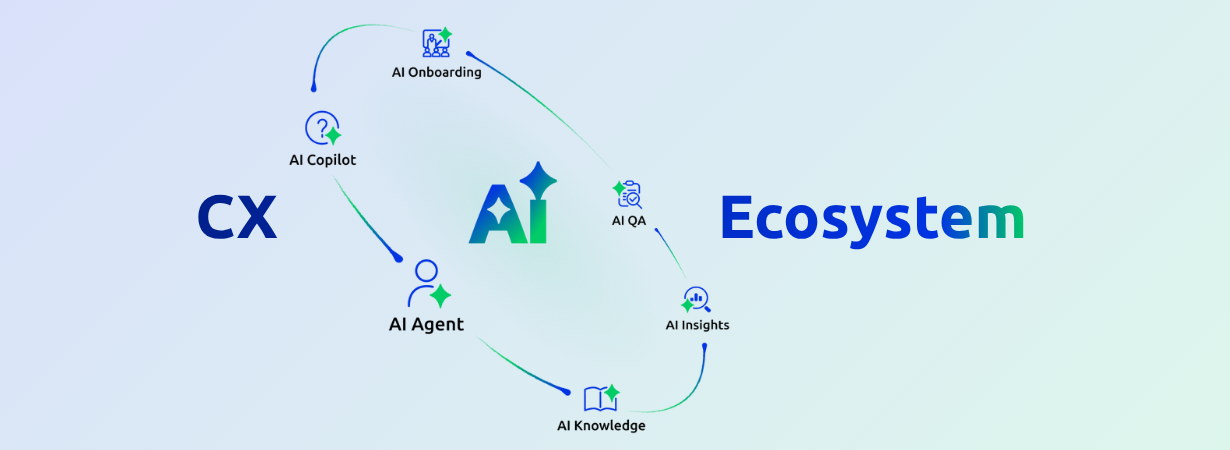It wasn’t too long ago that the idea of a CX Specialist would cause many furrowed brows. Fast-forward today, and the concept of customer experience (CX) has taken on a far larger meaning and importance within almost every industry.
In fact, according to Forrester, 72% of businesses say that improving the customer experience is their number one priority. And by the close of 2020, CX is forecast to overtake product and price as the key brand differentiator, according to Jacada Group.
CX is an incredibly rich topic, and it’s
one that’s here to stay. With this in mind, we sat down with Nate
Brown, CEO of Officium Labs and the Co-founder
of CX
Accelerator, a community and
resource hub for Customer Experience professionals. We picked his brains for
the very-best CX tips, predictions and expert analysis. Check out the interview
below.
Question
Hello and thank you for
joining us today to chat with us about your experience in the CX space Nate.
Let’s kick off this interview by having you introduce yourself to our audience.
Can you tell us about how you got started in the world of CX? What pulled you
in and never let you go?
Answer
Greetings and thank you so
much for the chance to do this! Customer
Experience is just the best… not just the work, but the people doing the work.
There is no other group like it!
I came into CX through the
left-field of Customer Service. I’d been managing a small software support team
at UL for quite a few years, and honestly was pretty fat and happy with the
whole situation. That’s when “The
Effortless Experience” by Matt Dixon and team rocked my world. Wrestling through that book caused something
to click in my mind…and stirred up a new hunger. The idea of designing great
experiences even BEFORE they reach customer service would change my whole
outlook on service.
Shortly thereafter I
received some coaching from Jeff Toister and Annette Franz on how to get an CX
initiative off the ground and I’ve been hooked ever since!
Question
On your site, you mention
that doing customer experience work alone can be challenging. Why is this? What
benefits does a group offer that a business (or a person) interested in CX
can’t get on their own?
Answer
Yes, goodness. I’m glad you
called that out. CX is absolutely the right thing to do (both for people and
the business) but this does NOT make it easy. Think of all the skills that a CX
professional has to have – everything from a data scientist to a project
manager, to a motivational speaker. When
you consider how hard it is to get people to change their mentalities and
behaviors it can be very easy to burn out.
A strong CX Change Coalition (which is cross functional in nature) is
essential to prevent this.
Additionally, having external support from encouraging and like-minded professionals is so critical. (Shout out to all my #CXSoulMates in CX Accelerator ☺ )
Question
You mention that a lot of
data that comes into organizations on a daily basis gets disregarded because it
comes into the company in the form of unstructured organic feedback. Can you
begin by telling us a little bit more about what unstructured feedback is and
why companies have a hard time dealing with this type of data?
Answer
Most organizations have a hard-enough
time doing something meaningful with traditional survey data. Things get a lot more
complicated when people are no longer bound to a specific survey format. While the complexity skyrockets, so does the
usefulness of the data.
The question organizations
need to ask here is “where are my customers talking about me, and how can I best listen?” Jeanne Bliss has a wonderful section in Chief Customer Officer 2.0
about creating listening paths of various types. When we bring structured and unstructured
data together inside of an effective Customer Experience Management platform,
it’s amazing the story that can be told!
Question
Omni-channel unstructured
customer feedback makes things even more challenging. Unstructured feedback can
enter into an organization at every single level of the organization from
front-line customer service reps to senior executives. How can an organization
deal, not only with unstructured data, but also data coming in through
different levels of the organization?
Answer
A great question to ask,
and one that illuminates the need for an a very good centralized hub for all
customer feedback. The classic scenario
is that executives will send a whole series of emails copying 100 people…while
simultaneously expecting lower-level employees to go through a proper
documentation process. The result is
frustration on all sides, and worse yet customer feedback will disappear into a
vacuum.
The greatest thing a CX leader can do is to make it very quick, easy, and maybe even a little fun for anyone in the company to capture customer feedback in a consistent manner. I’ve had success using a flashing USB button to streamline the process, offer a physical reminder, and establishing a new behavior pattern in our employees. This is just one example and I’ve had many CX leaders customize the concept for their own corporate context. Think about what is going to be the easiest way for any employee to capture feedback in real time.
Question
A lot of companies collect
data, but then disregard it. In your experience, what are the three most common
reasons why companies would collect customer feedback, but then not act on it?
Answer
It is baffling how often
this happens. I can’t really throw
stones, however, because I’ve done it myself!
It seems like such a simple thing to act on the data you have. A few things can and often do happen however:
- There are no clear and obvious trends that jump out from the VoC data. It would be a lot easier if there was a proverbial “smoking gun” after every round of relationship surveys. The reality ends up being that you have to choose to help one group of customers, but perhaps even to the detriment of another customer set. It can be tricky to isolate the actions that will result in maximum ROI.
- The inevitable brick wall. It seems like in almost every company there is that one thing or maybe even a couple things where they are just stuck. You might have 80 percent of your customer base complaining about something a regular basis, but it will not matter. This could be the result of an ineffective toolset, a political situation, or worse yet a dismissive attitude from Senior Leadership.
- We did act on it. But you will never know! If a tree falls in the woods with no one around does it make a sound? If a CX problem is solved, but it’s never communicated does it really matter? So often we actually are successful in using feedback to solve a problem, but we fail to close the loop and give ourselves any credit for it! Having the ability to celebrate with your customers when they had an impact on your products or service is essential. This can be done through things like a user community, proactive outreach, in-product dialogue boxes, and more.
Question
On your website you mention that “it’s critical to establish an emotional connection to the customer’s journey and keep the efforts human-centric.” Can you explain in further detail what you mean by this?
Answer
CX is the work of making people’s lives better and easier. We could have the sharpest dashboard in the world…and the absolute most intelligent experience strategy…but if we can’t demonstrate why this matters in the context of the people we serve than what does it matter? Being smart from a business perspective earns us the right to do the work. Enhancing the quality of life for our customers makes the work worth doing.
Question
On your website, there was
one section that really struck me. You talk in detail about different methods
of improving CX. However, you also mention that lasting experiences almost
always come down to the need for a culture change. You say that “many
organizations give an impression of being customer-centric, but in reality are
only posturing.” What are some first steps that companies guilty of posturing
can take to start the process of an internal culture change? Are these changes
usually top down?
Answer
I believe most companies
truly want to be customer-centric. The
steps involved in getting there are just…well…painful. A metaphor that I’ve used to describe this
process is viewing your company like a piece of real estate. There is “the gate, the fence and the
house.” The senior leadership team must
first clarity the culture they are working to create, and identify the specific
behaviors and mentalities associated with this culture. Now we are tenacious about only hiring people
who match new reality. This is “the
gate,” and the action is only letting people in who will add to the new culture
in a positive way.
“The fence” is even
harder. At this point, senior leadership
is activity demonstrating and communicating the new culture. They are activity reinforcing the behaviors
and mentalities identified at every opportunity. Essentially, they are pushing employees off
“the fence” and forcing a decision.
Either they jump into the new culture with both feet… or they make a
decision to leave the residence. Both
outcomes will bring you closer to a customer-centric culture, however this is a
painful and extended transition.
Honestly most organizations do not the appetite for it long-term. This
is why we see so many great culture initiatives that sadly burn-out.
“The house” is all about
your new group of employees. They have
committed themselves to the culture and are actively demonstrating the
behaviors and mentalities correlated to great CX. This hardly means our culture transformation
is complete, however. Senior leaders
must continue to be diligent in their reinforcement and prevent the inevitable
“culture drift” that can happen so quickly.
This post breaks it down in much more detail.
Question
Another big issue you talk about is the
problem of consistency when it comes to designing and executing a CX campaign.
As you previously mentioned, most companies give lip-service to the concept of
CX and any initiatives are forgotten about once “more critical” priorities pop
up. This might tie back to culture change, but it could also tie back to
certain resource limits within the company. In your experience, what are some
systems or processes you’ve seen put in place, that help companies with
improving their consistency?
Answer
Hum yes. A challenge for so many of us given the long-term nature of CX work. It’s helpful to think in terms of Customer Experience (CX), and Customer Experience Management (CXM). CX is can be very lofty and generic. On the tip of everyone’s tongue one day… and forgotten the next. But when we embed CX inside of a change management framework (CXM), the business becomes dependent on CX in a very healthy way. Decisions are made through the lens of CX. Performance management is done through a lens of CX. Strategy is created with the customer’s voice strongly represented. These behavior / mentality changes take time to earn, but once they are in place CX can stand the test of time. The greatest single thing you can do is establish a robust CX Change Coalition that is cross-functional in nature.
Question
You have a quote on your
website from Chris Zane that I really like. The quote is “customer service
starts where customer experience fails”. Are entirely different approaches
required for customer service vs. customer experience? Or are they simply
different sides of the same coin?
Answer
Wow I hated this quote when
I first saw it. It made me defensive as
someone who had been working in Customer Service for a decade. And let’s face it, Customer Service doesn’t
general get the respect that it should.
Upon further reflection
this is a brilliant statement. In its
most basic sense, Customer Service is the defensive unit for an
organization. It’s there for damage
control when things go wrong. “The Effortless Experience”
has a very compelling section on this and demonstrates how typical customer
service interactions are far more likely to generate disloyalty versus
loyalty. As CX professionals, we want to
design experiences that are so good, it will lessen our dependence on
traditional Customer Service.
Customer Service workers
should not take offense of this or be threatened by this. In fact, it demonstrates a tremendous
opportunity to shift their thinking towards experience design. Enhancing self-service capabilities, driving
Voice of Customer Programs, and implementing initiatives such as Knowledge
Centered Service will make them leaders in the Customer Experience effort. This makes Customer Service more strategic
than ever before and brings us that respect!
Question
Lastly, who is a company
that you believe is a leader in the CX space? What is it about their culture,
processes or systems that inspire you as someone so deeply involved in the CX
space?
Answer
Ramsey Solutions in Nashville, Tennessee comes to mind. It’s chartered by none other than famous financial radio personality, Dave Ramsey. Dave is fanatical when it comes to developing an authentic, customer-centric culture. The employees of this organization serve with fierce pride. If you’re not living the mantra of “helping others and extending hope”, you won’t be there for long. This laser focus draws exactly the right talent from all over the world and generates devoted fans. This causes the entire community takes notice…and ultimately customers win. They are a lesson to all of us in how to create a compelling and dynamic brand.
Download now: Never Miss a VIP White Paper
Learn how to define your VIPs, the tricks to identifying them across all digital channels, and how to provide them with that white-glove treatment so they keep coming back for more.
Download Now
Whitepaper







